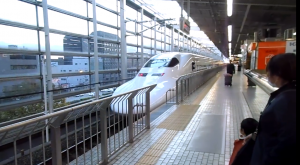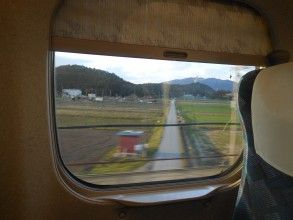Lawmakers embark on high-speed journey through Japan
 As California moves forward with the state’s first high-speed rail system, questions remain about the viability of the $68 billion transportation project.
As California moves forward with the state’s first high-speed rail system, questions remain about the viability of the $68 billion transportation project.
In an effort to better understand the challenges posed by high-speed rail, a delegation of three state Senators spent the Legislature’s spring break in Japan to investigate the first and, arguably, best high-speed rail system in the world.
Senate President Pro Tem Kevin de Leon, D-Los Angeles, Senate GOP leader Bob Huff, R-Diamond Bar and Sen. Hannah-Beth Jackson, D-Santa Barbara, began the four-day trip with a briefing from the U.S. Embassy in Tokyo before moving on to Osaka, Kobe and Kyoto. The delegation also received a tour of the country’s High Speed Rail Operation Center and discussed transportation, seismic safety, clean energy, environment and climate change with various Japanese officials, including Issei Kitagawa, the country’s transportation and tourism minister.
Here at CalWatchdog.com, we don’t think a few state Senators should have all the fun. That’s why we packed our bags and headed to Tokyo to research Japan’s world-class rail system for ourselves.
Japan: World leader in high-speed rail
 What makes the Japanese experts on high-speed rail? For starters, it’s the birthplace of high-speed rail. Since its opening in 1964, the Shinkansen has transported an estimated 5.6 billion passengers throughout the third largest economy in the world. The phrase “bullet train” comes from the Japanese translation of “dangan ressha,” which was used to describe Japan’s first high-speed rail system.
What makes the Japanese experts on high-speed rail? For starters, it’s the birthplace of high-speed rail. Since its opening in 1964, the Shinkansen has transported an estimated 5.6 billion passengers throughout the third largest economy in the world. The phrase “bullet train” comes from the Japanese translation of “dangan ressha,” which was used to describe Japan’s first high-speed rail system.
“Japan’s high-speed rail system is one of the best if not the best in the world,” Huff explained following the trip. “It has a safety record unparalleled in a seismically active country with a lot of similarities to California.”
Safety, especially as it related to earthquakes, is perhaps the most important takeaway for California. Japan boasts an impressive safety record – with no major injuries in 50 years. During the tragic 8.9 magnitude earthquake in 2011, trains were sent an automatic shut-off command from a control center in Kinkazan. That warning gave 33 trains enough time to safely stop.
Japanese bullet trains, which travel up to 200 miles per hour, are prepared for other natural disasters. When a bullet train in Northern Japan derailed during a 2013 blizzard, none of the 130 passengers and crew on board were injured.
Huff: Rail works with high-density populations
 While California can incorporate Japan’s safety protocols into its design and construction, the state will have a harder time matching ridership, in part, due to vastly different transit habits and urban growth patterns.
While California can incorporate Japan’s safety protocols into its design and construction, the state will have a harder time matching ridership, in part, due to vastly different transit habits and urban growth patterns.
“The biggest difference is they have a high density population that has not evolved around a ‘car culture’ as we have here,” Huff explained. “Only half of Japan’s population own a car, and all of the associated costs of ownership – parking, gas and everything else – are prohibitively expensive. Taken together that creates the raw ingredients for a successful high-speed rail system.”
As Slate’s Eric Holthaus points out, air travel is ingrained in American travel, with rail barely a blip. “In 2012, Americans traveled nearly 3 trillion passenger-miles by car, 580 billion by air, and more than 300 billion by bus,” Holthaus wrote in January. “Passenger rail was barely even comparable—just 7 billion passenger-miles.”
Supporters of high-speed rail say that U.S. passengers don’t embrace rail because it’s currently too slow. Throughout the world, transportation experts have cited a 3-hour rule for travel– passengers prefer rail for journeys under three hours. In his review of high-speed rail research, Chris Nash of the Institute for Transport Studies at University of Leeds concluded, “Targeting air markets where rail journey times can be brought close to or below 3 hours therefore does make sense.”
California likely to break 3-hour rule
Japan’s well-designed system easily meets that three hour rule, allowing passengers to fly through security and arrive at the station just minutes before departure. A trip from Nagoya to Kyoto, which would have been a two-hour journey by car, took under 40 minutes on high-speed rail. And the rush hour commute to Nagoya station was so bad that it took longer to reach the station than the trip itself.
That’s why Japanese airlines are steadily losing ground to the bullet train. “Six out of 10 travelers on the Tokyo-Hiroshima line used to fly the route, but now the ratio has reversed in favor of the bullet train,” Nikkei Asian Review observed in 2013.
California’s high-speed rail system faces the opposite problem, where airlines can transfer passengers from Los Angeles to San Francisco in under 90 minutes. The state’s planned route has also extended the travel time and will likely break the important 3-hour travel rule.
Last year, Louis Thompson, chairman of the High-Speed Rail Peer Review, testified before a state Senate committee that California’s system would not meet the anticipated trip times of two hours and 40 minutes, according to the Los Angeles Times.
Japanese high-speed rail encourages growth
Fewer riders translates into concerns about profitability. To make Japan’s high-speed rail system more profitable, rail companies own the surrounding land and are encouraged to develop.
The Economist noted that Japan’s system “thrives because of a planning system that encourages the building of commercial developments and housing alongside the railway route. JR East owns the land around the railways and lets it out; nearly a third of its revenue comes from shopping malls, blocks of offices, flats and the like.”
Given California’s environmental laws and anti-development mentality, it’s hard to envision the state embracing new major development projects.
For Huff, the trip left lingering doubts about California’s current high-speed rail plan.
“My takeaway for California is that if Governor Brown intends to continue pushing for a high-speed rail system he might be better served by starting in the big cities and building systems that will help connect people immediately, and then expand later,” he said.
Related Articles
CARB Set To Boost CA Gas Prices
NOV. 22, 2010 By DAVE ROBERTS Buoyed by the repudiation of Prop. 23, the California Air Resources Board (CARB) is
CA oil industry celebrates defeat of fracking moratorium
California’s oil industry is celebrating the defeat of a bill that would have placed a moratorium on hydraulic fracturing
Schools pooling up to oppose arbitrary storm-water tax
Dec. 27, 2012 By Wayne Lusvardi Why is only Los Angeles County being singled out to comply with a new



